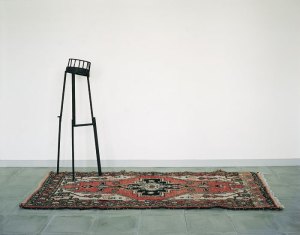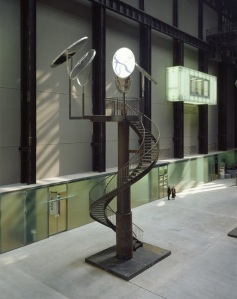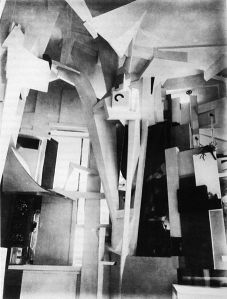Juan Munoz, Louise Bourgeois, Kurt Schwitters

Juan Muñoz Minaret for Otto Kurz 1985, Collection of Francis de Beir
Muñoz considered Spiral Staircase (1984) to be his first mature work as a sculptor. Like the balconies, it was inspired by a familiar architectural structure and similarly represents a transitional ‘in-between’ space, embodying the momentum of both descending and ascending. ‘It made me very aware of the possibility of working on a reduced scale’, he later said. ‘I’m continually interested in how something small can animate a large amount of space.’
The Persian carpet of Minaret for Otto Kurz (1985) demarcates the space around the welded iron tower, but also acts ‘like a map of the city’, Muñoz said. ‘The first time I placed the piece in my studio, I always had this feeling that this tower was overlooking the city.’ Otto Kurz was a Viennese art historian who captured Muñoz’s imagination after he came across a reference to a major book that Kurz had written about ‘the prohibition of images in different cultures’, particularly Islamic cultures. After an intensive search, Muñoz discovered that the book never progressed beyond a stack of unconnected notes and references.
http://www.tate.org.uk/modern/exhibitions/juanmunoz/rooms/room2.shtm
Louise Bourgeois – I Do, I Undo and I Redo
The installation consists of three steel towers, entitled I Do, I Undo and I Redo. The towers, each some 9 metres (30 ft) high, will dominate the east end of the Turbine Hall. In I Do and I Redo, spiral staircases coil around central columns supporting platforms which are surrounded by a number of large circular mirrors. In I Undo, a square framed steel skin with a spiral staircase conceals a cylindrical core with a further staircase. In each tower, Bourgeois has placed a bell jar containing sculpted figures of a mother and child.
Visitors can climb the staircases to the platforms, which Bourgeois envisages will become stages for intimate and revelatory encounters between strangers and friends alike. These encounters can be viewed from the bridge across the Turbine Hall and the viewing platforms looking over the space, increasing the idea of a spectacle. The huge mirrors reflect the encounters between the participant and the architecture, the viewing public and the towers.
http://www.tate.org.uk/modern/exhibitions/bourgeois/photos.shtm
A photo of the Merzbau, 1933
Source
The collages Of Kurt Schwitters, Dietrich, Cambridge, 1993
The Merzbau by Kurt Schwitters.
Leave a comment